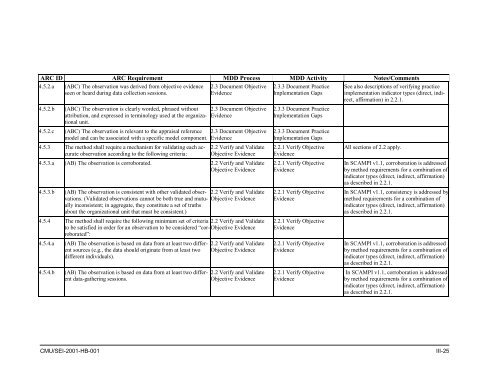Standard CMMI Appraisal Method for Process Improvement (SCAMPI)
Standard CMMI Appraisal Method for Process Improvement (SCAMPI)
Standard CMMI Appraisal Method for Process Improvement (SCAMPI)
Create successful ePaper yourself
Turn your PDF publications into a flip-book with our unique Google optimized e-Paper software.
ARC ID ARC Requirement MDD <strong>Process</strong> MDD Activity Notes/Comments<br />
4.5.2.a (ABC) The observation was derived from objective evidence<br />
seen or heard during data collection sessions.<br />
2.3 Document Objective<br />
Evidence<br />
2.3.3 Document Practice<br />
Implementation Gaps<br />
See also descriptions of verifying practice<br />
implementation indicator types (direct, indirect,<br />
affirmation) in 2.2.1.<br />
4.5.2.b<br />
4.5.2.c<br />
(ABC) The observation is clearly worded, phrased without<br />
attribution, and expressed in terminology used at the organizational<br />
unit.<br />
(ABC) The observation is relevant to the appraisal reference<br />
model and can be associated with a specific model component.<br />
4.5.3 The method shall require a mechanism <strong>for</strong> validating each accurate<br />
observation according to the following criteria:<br />
2.3 Document Objective<br />
Evidence<br />
2.3 Document Objective<br />
Evidence<br />
2.2 Verify and Validate<br />
Objective Evidence<br />
4.5.3.a (AB) The observation is corroborated. 2.2 Verify and Validate<br />
Objective Evidence<br />
4.5.3.b (AB) The observation is consistent with other validated observations.<br />
(Validated observations cannot be both true and mutu-<br />
Objective Evidence<br />
2.2 Verify and Validate<br />
ally inconsistent; in aggregate, they constitute a set of truths<br />
about the organizational unit that must be consistent.)<br />
4.5.4 The method shall require the following minimum set of criteria 2.2 Verify and Validate<br />
to be satisfied in order <strong>for</strong> an observation to be considered “corroborated”:<br />
Objective Evidence<br />
4.5.4.a<br />
4.5.4.b<br />
(AB) The observation is based on data from at least two different<br />
sources (e.g., the data should originate from at least two<br />
different individuals).<br />
(AB) The observation is based on data from at least two different<br />
data-gathering sessions.<br />
2.2 Verify and Validate<br />
Objective Evidence<br />
2.2 Verify and Validate<br />
Objective Evidence<br />
2.3.3 Document Practice<br />
Implementation Gaps<br />
2.3.3 Document Practice<br />
Implementation Gaps<br />
2.2.1 Verify Objective<br />
Evidence<br />
2.2.1 Verify Objective<br />
Evidence<br />
2.2.1 Verify Objective<br />
Evidence<br />
2.2.1 Verify Objective<br />
Evidence<br />
2.2.1 Verify Objective<br />
Evidence<br />
2.2.1 Verify Objective<br />
Evidence<br />
All sections of 2.2 apply.<br />
In <strong>SCAMPI</strong> v1.1, corroboration is addressed<br />
by method requirements <strong>for</strong> a combination of<br />
indicator types (direct, indirect, affirmation)<br />
as described in 2.2.1.<br />
In <strong>SCAMPI</strong> v1.1, consistency is addressed by<br />
method requirements <strong>for</strong> a combination of<br />
indicator types (direct, indirect, affirmation)<br />
as described in 2.2.1.<br />
In <strong>SCAMPI</strong> v1.1, corroboration is addressed<br />
by method requirements <strong>for</strong> a combination of<br />
indicator types (direct, indirect, affirmation)<br />
as described in 2.2.1.<br />
In <strong>SCAMPI</strong> v1.1, corroboration is addressed<br />
by method requirements <strong>for</strong> a combination of<br />
indicator types (direct, indirect, affirmation)<br />
as described in 2.2.1.<br />
CMU/SEI-2001-HB-001<br />
III-25
















